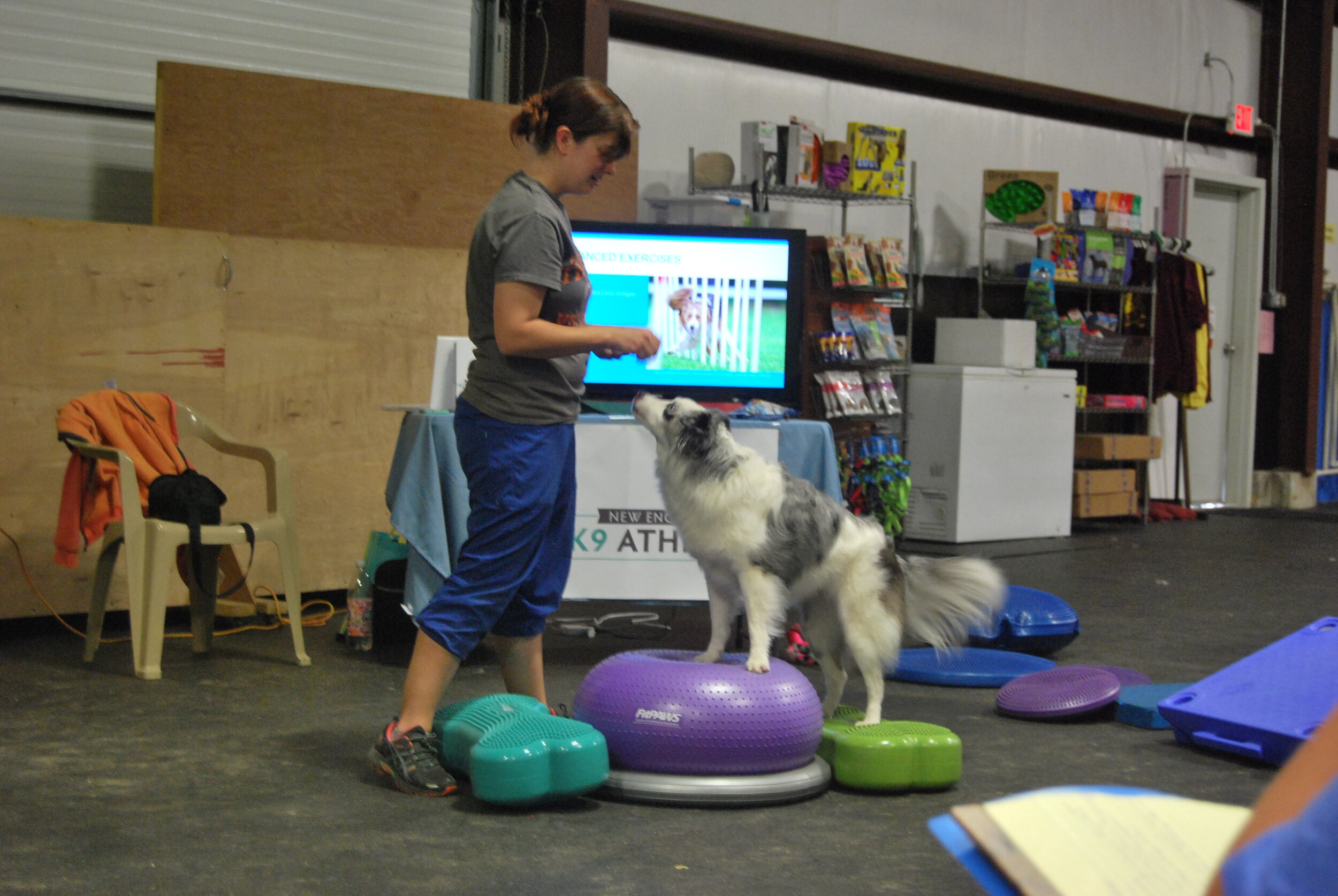Canine Fitness Circuit Training
/What is “Circuit Training”?
Circuit training is commonly used in human fitness and it is something we can adapt to use for canine fitness training as well! The concept behind circuit training is fairly simple; you have the dog complete a sequence of exercises with little to no rest in-between each exercise, until the circuit is complete. Typically I will set up “stations” for each exercise (some can be used for multiple exercises) prior to starting the circuit; this way you eliminate the rest time in-between exercises that you would be using to set up the next exercise. With everything all set up in stations you can quickly move from one exercise to another.
Benefits of Circuit Training for Your Dog
Time: Many of us are short on time or if you are like me and you own multiple dogs it isn’t really realistic to be spending 30 minutes doing fitness with each dog individually all the time (5 dogs x 30 minutes = 150 minutes (or 2.5 hours), ain’t nobody got time for that). You can set up one circuit with 4-5 stations and you can adapt that to each dog, therefore reducing the time you spend setting up exercises for each dog/exercise.
Prevents boredom: Whether your dog is a beginner or advanced in the world of canine fitness, mental stamina can be a challenge. For both levels of dogs we don’t want them to become bored by doing the same exercise over and over and over again. When that happens we can start to lose good form or engagement with our dogs and we don’t want either of those! Using a circuit style training method can help you and your dog (because let’s be honest I get bored doing the same thing too) stay eager and engaged during your fitness session. By breaking up the exercises appropriately for your level of dog overtime you can help build mental stamina as well!
Muscular endurance: Circuit training is well known for it’s ability to build muscular strength and endurance in humans. By performing a variety of exercises in a row with minimal rest to the end of the circuit you are not only building muscular strength, but you are also building up your dog’s muscular endurance (the ability for your dog to perform for longer and longer periods of time).
Cardio benefit: You can incorporate small bouts of cardio exercises into your circuit in addition to your strength and core exercises. Simply by performing the circuit you are increasing your dog’s cardio benefit due to the back-to-back exercises with minimal rest.
How to Build a Circuit Training Plan for Your Dog
“The classic interpretation of the circuit is four-plus exercises with rest held until the end of the sequence"
Our goal here is to incorporate separate exercises that target different muscle groups so we are getting a complete body workout for our dog.
An example of a balanced circuit plan:
Front Limb Strength Exercise (example: bow to stand or sit to down)
Rear Limb Strength Exercise (example: tuck sit to kickback stand or rockback sit to stand)
Cardio Exercise (example: quick (1 minute) trot on the treadmill or stair climbing)
Core Strength Exercise (example: spin on unstable object or folding down to stand)
Compound Strength Exercise (targeting multiple areas, example: hups or powerdrills)
1 minute of rest then repeat
Your next question will be “How do I figure out the number of sets and reps?”. This depends largely on where your dog is in their fitness. If your dog is a beginner then do not jump right to 5 stations in a circuit, start small maybe only 3 stations. Keep your reps low so your dog can be successful. Maybe start with 5 reps of each exercise and 2 sets of the circuit (complete the circuit once, rest, complete it again). I would rather have someone start a level that is very easy for their dog and have them slowly make it harder than jump in too fast and overload the dog. If your dog is more advanced then maybe start with 10 reps and 3 sets of the circuit.
Keep in mind:
as you advance and make the exercises more complex/harder make sure you lower your reps and sets to allow them to adjust!
if you are struggling or are lost at where to start or how to progress with your dog in circuit training then please reach out to an accredited canine fitness trainer for help.
Warming Up and Cooling Down
Remember: it is always important for you to appropriately warm up your dog before starting a circuit and to properly cool them down. Your warm up/cool down should last 5-10 minutes depending on your dog and the conditions (is it hot out? is it cold out?). We discuss warming up and cool down in almost all our online classes and seminars/workshops so please let us know if you have any further questions regarding this.
Some examples of warm ups include:
5 (or so) minute walk on a treadmill or on a leash
Spinning (both directions)
Leg weaving
Lateral Stepping
Backing Up
I use my cool down time to work on some flexibility with my dogs and do some active stretching exercises. We cover these and more in our “Let’s Flex” online class as well as all our other online classes.
Some examples of cool down active stretching exercises include:
High Stand (Hip Flexor) Stretch
Cookie Stretch
Bicep Stretch
Neck Stretch
Psoas Stretch


